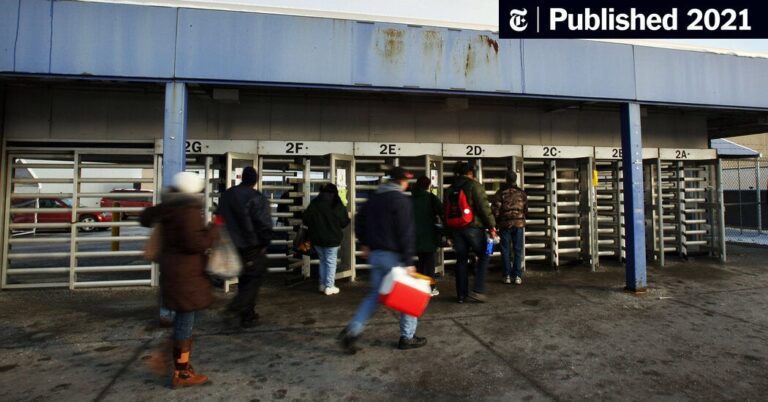WASHINGTON — The Midwest's share of the Democratic presidential vote fell steepest between 2012 and 2020 in counties that saw the biggest losses in manufacturing and union jobs and declines in health care, according to a new report to be released this month.
The party's worsening performance in the region's middle-class communities — often overlooked places like Chippewa Falls, Wis. and Bay City, Mich. — poses a formidable threat to Democrats, the report warns.
Nationally and in the Midwest, Democratic gains in major metropolitan areas offset their losses in rural areas. And while the party's struggles in the industrial Midwestern state are well-timed, the 82-page report explicitly links the Democratic decline in the region that elected Donald J. Trump in 2016 with the kind of deindustrialization that has weakened liberal parties around the world.
“We can't elect Democrats up and down the ballot, much less protect our governing majorities, if we don't address these losses,” Richard J. Martin, a market researcher and veteran Iowa-based Democratic campaigner, wrote in exhibition entitled “Factory Towns.”
Mr. Martin co-authored the report with Mike Lux and David Wilhelm, fellow Democratic strategists who, like him, also have roots in the area and worked on President Biden's 1988 presidential campaign.
For all the compelling data, vivid charts and deeper red charts presented, Mr. Martin provides little guidance on how to reverse trends. But he offers a warning, one that Midwestern Democrats have issued since Mr. Trump's victory five years ago.
“If things continue to get worse for us in the small and medium-sized working-class counties, we may give up all hope of winning the battleground states of the industrial heartland,” Mr. Martin writes.
Surveying ten states – the Great Lakes region, as well as Missouri and Iowa – Mr. Martin presented a series of stark figures.
Comparing Barack Obama's re-election to President Biden's election last year, he notes that Democrats won about 1.55 million votes in the major cities and suburbs of the region surveyed. During the same period, they lost about 557,000 votes in heavily rural counties.
But in mid-sized and small counties, Democrats lost more than 2.63 million votes between the two elections. Calling these communities “factory towns,” Mr. Martin separates them with mid-sized counties that are anchored around cities of 35,000 or more and smaller counties that rely on manufacturing but don't have such large cities.
Taken together, the changes show the extent to which Mr. Obama relied on the votes of white, working-class voters to propel his re-election — and how much Mr. Biden leaned on the suburbs to offset his losses in once-rich working-class communities. he was a pillar of the Democratic coalition.
What worries Mr. Martin, and many Democratic officials, is whether the party can maintain those gains in metropolitan areas. It's uncertain, as he puts it, “whether moderate suburban Republicans will continue to vote Democratic when Trump isn't on the ballot.”
Democratic gains up and down the ballot in fast-growing Sun Belt states like Arizona and Georgia garnered significant attention last year. But Mr. Biden would not have won the presidency, and Democrats could not have flipped the Senate without victories in the Great Lakes region in 2020.
However, those victories proved more difficult than many pre-election polls concluded because of the GOP's continued strength in manufacturing communities. And, the report notes, these communities made up a significant portion of the region's vote share. In Wisconsin, medium and small manufacturing counties make up 58 percent of the statewide vote. In Michigan, half the voting population is in these communities.
This is where the decline in manufacturing has been most damaging to Democrats. The ten states included in the survey have lost 1.3 million manufacturing jobs since the beginning of this century.
In the small to medium-sized “factory town” counties in these states, where support for the Republican presidential nominee rose between 2012 and 2020, the losses were sharp: More than 70 percent saw a decline in manufacturing jobs.
The elimination of these jobs also led to a reduction in health care, according to data from the Robert Wood Johnson Foundation and the University of Wisconsin Population Health Institute.
In counties that suffered manufacturing losses and health care declines, Republicans surged between 2012 and 2020. Nearly half of the party's gains in those states came in communities where there were cuts in manufacturing and deteriorating health care.
Republicans also prospered in predominantly white communities hit hard by the decline of manufacturing. With fewer good-paying manufacturing jobs, the power of local unions also declined, silencing what had always been the heart of democratic political organization in these areas. In 154 such counties, Democrats suffered a net loss of more than 613,000 votes between the 2016 and 2020 elections.
Perhaps most striking was the decline in union membership across the region.
Nine of the 10 states included in the survey accounted for 93% of the loss of union membership nationally over the past two decades. And in just the last 10 years, these states have lost 10 percent of their union membership — an average that's three times higher than nationally.

